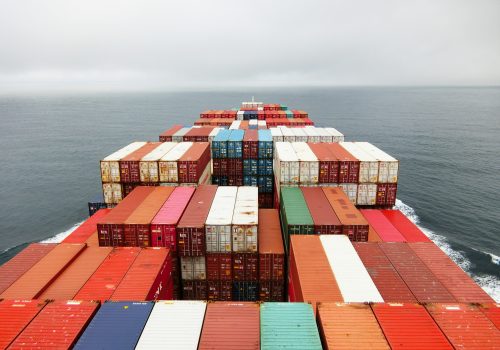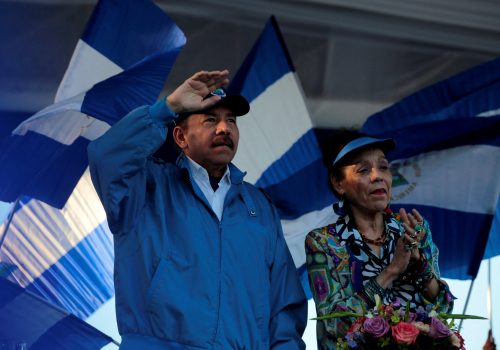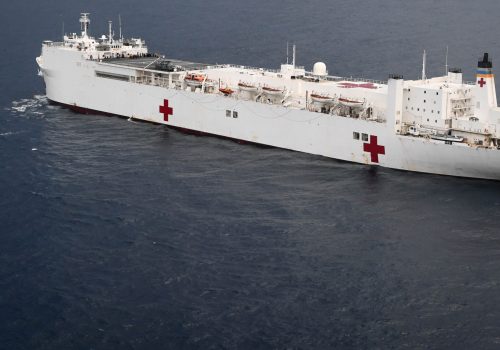US-China vaccine diplomacy: Lessons from Latin America and the Caribbean
Introduction
COVID-19 has laid bare the competing strategies and practices of the United States and China to amass further clout in Latin America and the Caribbean (LAC). In many ways, the pandemic is quickly accelerating a regional trend seen over the last decade: China uses its growing economic and diplomatic muscle to provide an alternative to US activities and interests. The implications of diverging COVID-19 responses, notably at the onset of the pandemic’s rise in the region, will reverberate beyond the health sector. What might the differing US and China pandemic approaches portend for future influence in the region?
For the United States and China, the pandemic has opened new opportunities to deepen regional ties. Both countries’ assistance eventually centered on vaccine diplomacy, but China was first out of the gates in offering vaccinations beyond its borders.
For LAC, its interactions with the United States and China during the pandemic are emblematic of broader trends: China provides an alternative to LAC during crisis moments; and regional leaders use US-Chinese competition to their advantage. Both instances are visible in the region, including in the four geographic areas analyzed in the following pages: Central America, Trinidad and Tobago (T&T), Brazil, and Mexico. In each case, distinct US and Chinese engagement at various stages of the pandemic—along with the host countries’ own actions and reactions—have yielded short-term results and some that are likely to persist.
In Central America, China provided strategic diplomatic messaging alongside vaccine shipments, but the United States donated more vaccines. In T&T, Chinese vaccines were accompanied by a new loan, and the country’s prime minister applied a pragmatic approach to acquire vaccines from both the United States and China. For Brazil, laboratory-to-laboratory agreements highlighted a different version of vaccine diplomacy: one that occurs at the subnational level. In Mexico, numerous diplomatic exchanges occurred alongside substantial vaccine purchases from US and Chinese manufacturers.
Vaccine-related diplomacy also contributes to an evolving discussion about the different ways China and the United States more broadly engage the region—and vice versa. Starting from a low base, Chinese engagement with LAC has focused on and grown significantly in diplomacy, trade, and investment over the last decade. China is either the first- or second-largest trading partner for many countries in the Americas and a top source of foreign direct investment among its allies. Current US strategy in the region similarly reflects a new sense of deploying diplomatic tools to advance hemispheric prosperity, while doing so as part of a broader vision that reflects partnering to address global challenges—from climate change and the instability that sparks migration to shoring up democracy and addressing corruption. Overall, the region’s proximity, shared peoples, history, and borders with the United States provide greater depth and multidimensionality to the relationship. Consequently, vaccine diplomacy represents a greater marginal opportunity for China to broaden and deepen regional ties.
Central America (Belize to Panama)
By María Eugenia Brizuela de Ávila
Central America has a deeper and more extensive relationship with the United States than China. Bilaterally and through COVAX (the international cooperative program), the United States donated and supplied more vaccines to Central America than China.1“China COVID-19 Vaccine Tracker,” Bridge Beijing, accessed November 1, 2021, https://bridgebeijing.com/our-publications/our-publications-1/china-covid-19-vaccines-tracker/. See also Chase Harrison, “Tracker: U.S. Vaccine Donations to Latin America,” Americas Society/Council of the Americas, last modified October 28, 2021, accessed November 1, 2021, https://www.as-coa.org/articles/tracker-us-vaccine-donations-latin-america. Migratory flows through the region to the US-Mexico border and strong economic linkages make Central America a strategic location for US interests. Remittances, the Dominican Republic-Central America Free Trade Agreement (DR-CAFTA), in which the United States enjoyed a goods trade surplus of $7 billion,2“CAFTA-DR (Dominican Republic-Central America FTA),” Office the United States Trade Representative (website), accessed December 23, 2021, https://ustr.gov/trade-agreements/free-trade-agreements/cafta-dr-dominican-republic-central-america-fta#:~:text=The%20U.S.%20goods%20trade%20surplus,134%20thousand%20jobs%20in%202014. migratory flows, and shared tourism demonstrate these multifaceted US-Central American ties. In addition, the effectiveness of US-origin vaccines is positively rooted in people’s minds.
US-China competitive dynamics in Central America have been on full display since the pandemic. The US government announced $310 million in humanitarian assistance to El Salvador, Guatemala, and Honduras in April 2021.3“United States donates 1.5 million COVID-19 vaccines to El Salvador,” US Embassy in El Salvador, last modified July 4, 2021, accessed November 1, 2021, https://sv.usembassy.gov/united-states-donates-1-5-million-covid-19-vaccines-to-el-salvador/. See also “U.S. Government Aid of 3 Million Vaccines Arrives in La Aurora,” US Embassy in Guatemala, last modified July 20, 2021, accessed November 1, 2021, https://gt.usembassy.gov/u-s-government-aid-of-3-million-vaccines-arrives-in-la-aurora/. China has donated its own vaccines to diplomatic allies in Central America and sold at least 1.5 million Sinovac doses to El Salvador.4“China to Send Fifth Batch of COVID-19 Vaccines to El Salvador,” State Council, People’s Republic of China, last modified July 7, 2021, accessed November 1, 2021, http://english.www.gov.cn/news/internationalexchanges/202107/07/content_WS60e50849c6d0df57f98dc833.html. China also cut attractive deals to deliver its vaccines at cheaper prices than US vaccines. Moreover, Beijing announced that it would provide $1 billion in financing to LAC countries to help them purchase Chinese vaccines, as discussed in the Trinidad and Tobago case study. Overall, US donations, including through COVAX, to Central America have totaled an estimated 16.8 million doses compared to China’s total donations to Central America of 1.75 million doses.5“COVID-19 Vaccine Donations,” US Department of State, accessed January 6, 2022, https://www.state.gov/covid-19-recovery/vaccine-deliveries/#map_western. See also “China COVID-19 Vaccine Tracker,” Bridge Beijing, accessed January 6, 2022, https://bridgebeijing.com/our-publications/our-publications-1/china-covid-19-vaccines-tracker/.
Vaccine shipments opened a new avenue for China to strengthen diplomatic ties. Chinese officials conflate the number of vaccine doses they donate and sell to other countries. Combining donations with purchased shipments allows China to capitalize on the optics of vaccine deliveries. Take El Salvador as an example. Although China only donated 750,000 vaccine doses to date, subsequent arrivals of El Salvadoran-purchased Chinese doses (totaling 5 million) were greeted with uncommon fanfare. On one occasion, purchased Chinese vaccines were delivered to El Salvador by a leased plane owned by the New England Patriots, a National Football League team.6Joshua Goodman, “New England Pats Give Flight to China’s Vaccine Diplomacy,” Associated Press, last modified May 21, 2021, accessed November 1, 2021, https://apnews.com/article/new-england-patriots-china-business-diplomacy-sports-430ed8696f101ad6739a90c53752c77a. The plane use drew significant international media attention, accentuating the perception that China was leading vaccine supply in LAC. More broadly, while US deliveries also received media attention, Chinese vaccine shipments (both purchased and donated) made a stronger public impression than most US donations delivered via COVAX.7Ibid.
To bridge this perception gap, US vaccine donations to Central America need to be more geo-strategically competitive. Bilaterally, the United States can expand its commitment to regional recovery by helping overcome in-country logistical challenges associated with vaccine administration. Many mRNA vaccines donated by the United States, such as the Pfizer vaccine, require ultracold-storage freezers to house them. Donations that come with the requisite equipment or training could build appropriate capacity for national and local governments to increase vaccination rates and reduce wastage. Additional support could include providing supplementary supplies like needles and alcohol pads and securing customs arrangements.
As the pandemic continues and more COVID-19 assistance is needed, vaccine diplomacy has laid the groundwork for China to broaden engagement with Central America. In December 2021, this played out with Nicaragua switching its diplomatic relations from Taiwan to China, and resulted in a donation of 200,000 vaccines less than a week later.8“Nicaragua Receives China Vaccines After Cutting Ties with Taiwan,” BBC News, accessed December 15, 2021, https://www.bbc.com/news/world-asia-59633388. Taiwan’s three remaining Central American allies (Honduras, Belize, and Guatemala) surely took notice. The swiftness and growing scale of Chinese support in moments of crisis—pandemics, climate events, or economic hardship—is likely to put additional pressure on Taiwan and its allies. When faced with resource constraints, these Central American countries, under stress, might see a pivot to China as advantageous to secure needed assistance for their citizens.9Mowla, Wazim, and Isabel Bernhard. “Why Might Taiwan’s Allies in Latin America and the Caribbean Soon Look to China?” Global Americans. Last modified January 6, 2022. Accessed January 11, 2022. https://theglobalamericans.org/2022/01/why-might-taiwans-allies-in-latin-america-and-the-caribbean-soon-look-to-china/.
The US response to the region during the pandemic complemented its approach in combatting the root causes of migration flows by improving security conditions and boosting economic prosperity. To advance US interests during future global events, it must be among the first to deliver aid, rethink how it communicates shipments, and identify additional political or economic accompaniments to enhance bilateral relations with Central American countries.
Trinidad and Tobago
In March and April 2021, Dr. Keith Rowley, as both chair of the Caribbean Community (CARICOM) and T&T’s prime minister, wrote to US President Joe Biden, spoke with US Congresswoman Maxine Waters, chair of the House Committee on Financial Services, and engaged with senior White House officials about vaccine access for the Caribbean.10“PM in Ongoing Talks with US on Vaccine Redistribution,” Government of the Republic of Trinidad and Tobago (website), accessed November 1, 2021, http://www.news.gov.tt/content/pm-ongoing-talks-us-vaccine-redistribution#.YYCwJZ7MLIU. He also spoke with Chinese President Xi Jinping and China’s ambassador to T&T in March 2021.11“Xi Jinping Speaks with Prime Minister Keith Rowley of Trinidad and Tobago on the Phone,” Chinese Ministry of Foreign Affairs (website), last modified March 16, 2021, accessed November 1, 2021, https://www.fmprc.gov.cn/mfa_eng/zxxx_662805/t1861971.shtml. US discussions eventually resulted in a letter from President Biden acknowledging the Caribbean’s need for vaccines while engagement with China was met with action – a $204 million loan and a total donation of 300,000 Sinopharm vaccines to T&T in May and June 2021.12Ryan Hamilton-Davis, “Trinidad and Tobago to Take Chinese loan to Buy Chinese Vaccines,” Newsday, last modified May 11, 2021, accessed November 1, 2021, https://newsday.co.tt/2021/05/11/trinidad-and-tobago-to-take-chinese-loan-to-buy-chinese-vaccines/.
The loan stipulated that at least 15 percent of the money should be used to purchase “goods and services from China,” which included Sinopharm vaccines, allowing T&T to purchase an additional 800,000 doses.13Jensen La Vende, “Trinidad and Tobago to Get 800,000 COVID-19 Vaccine Doses from China,” Newsday, last modified July 10, 2021, accessed November 2, 2021, https://newsday.co.tt/2021/07/10/trinidad-and-tobago-to-get-800000-covid19-vaccines-from-china/. China’s loan had fewer restrictions than one offered by the International Monetary Fund (IMF), which T&T rejected. The IMF loan had a lower interest rate but required structural readjustments that the T&T government felt it could not afford.
Distribution of US personal protective equipment (PPE) occurred earlier, but China donated vaccines first. US vaccines arrived on June 14 and August 14. The first donation was a mere 480 doses, which arrived on the same day as 200,000 from China. Unsurprisingly, Chinese and Trinidadian media criticized the US donation.14“Chinese Media Mocks US donation of 80 Vaccine Vials to Trinidad and Tobago,” Reuters, last modified June 16, 2021, accessed November 2, 2021, https://www.reuters.com/business/healthcare-pharmaceuticals/chinese-media-mocks-us-donation-80-vaccine-vials-trinidad-tobago-2021-06-16/. China’s diplomatic coup was only partially reversed when a larger US donation of 305,370 vaccines (from a promised 908,000) arrived on August 12, coinciding with a visit by Admiral Craig Faller, then-commander of US Southern Command.15“SOUTHCOM Commander Strengthens Partnerships During Visits to Trinidad and Tobago, Barbados,” US Southern Command (website), last modified August 13, 2021, accessed November 2, 2021, https://www.southcom.mil/MEDIA/NEWS-ARTICLES/Article/2731131/southcom-commander-strengthens-partnerships-during-visits-to-trinidad-and-tobag/. A second US batch (304,200) arrived on December 9, 2021.16“T&T to Receive 2nd tranche of COVID-19 vaccines from US Gov’t,” Loop News, accessed December 15, 2021, https://tt.loopnews.com/content/tt-receive-2nd-tranche-covid-19-vaccines-us-govt. The US donations to T&T are part of a larger four-million dose promise to CARICOM countries (excluding Haiti), compared to just over a million from China.
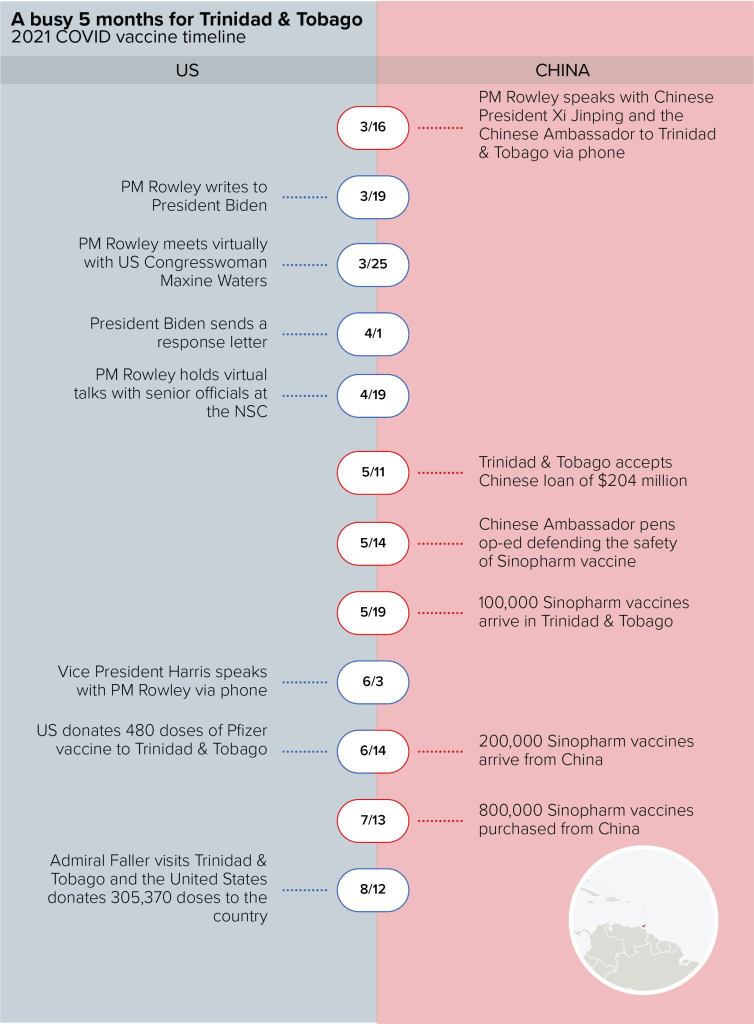
The United States often seems to take its relationship with the Caribbean for granted when it should be paying closer attention. Indeed, especially with China’s vaccine diplomacy, the United States should be wary of losing goodwill and influence in CARICOM to China’s benefit. The Caribbean is regarded as the US’s third border and, in addition to the region’s geostrategic importance, the US enjoys a trade surplus of $6.5 billion with CARICOM. T&T, a longtime US ally, sits in a strategic area in the Caribbean. It shares a maritime border with Venezuela, a key reason why Rowley maintains relations with the Nicolás Maduro regime, and T&T is a frequent destination for Venezuelan refugees.17Georgina Chami and Florence Seemungal, “The Venezuelan Refugee Crisis in Trinidad and Tobago,” University of Oxford Faculty of Law, last modified April 9, 2021, accessed November 2, 2021, https://www.law.ox.ac.uk/research-subject-groups/centre-criminology/centreborder-criminologies/blog/2021/04/venezuelan. As a larger Caribbean economy, T&T is a valuable trade partner, especially for US goods and services from Florida.
Yet limited or slow engagement during the pandemic has decreased US standing in T&T and the Caribbean. Rowley maintains a policy of autonomy in T&T’s relations with the United States and China, noting that they are “never a case of one or the other . . . as we look after the interest of the people of T&T.” Small states like T&T cannot afford to depend on one power. In an international system marked by asymmetrical relationships, these states maintain a diversity of relations.18Mowla, Wazim, and Pepe Zhang. “Latin America and the Caribbean’s asymmetrical engagement with China during the COVID-19 pandemic.” Georgetown Security Studies Review.
Renewed US commitment to T&T and the Caribbean opens the door for the United States to increase its support to help preserve the region’s health and to build back better after the pandemic. To counter Chinese influence, the United States must compete better and smarter. For instance, had US bilateral vaccine donations started sooner, they would have had a significant impact in Caribbean countries, given their smaller population size relative to Latin American neighbors—and that would have been a quick win for the United States and a meaningful first step toward health security and economic recovery. Consistent and sustained US support, via foreign aid and knowledge sharing, would help Caribbean countries better prepare for this and the next pandemic, as well as other sustainable growth challenges aggravated by pandemic-like shocks.
Brazil
In Brazil, vaccine dynamics centered on cooperation agreements with US, Chinese, and British manufacturers. Domestic production afforded Brazil greater control over the timing and consistency of vaccine supply—a fluctuating variable elsewhere in LAC. US and Chinese vaccine donations to Brazil are minimal relative to the rest of the region. Save for the US donation of three million doses of Johnson & Johnson’s vaccine announced on June 23—barely 1% of the 407 million doses distributed so far—Brazil’s remaining 404 million doses were acquired commercially.19“The United States Donates 3 Million Doses of Johnson & Johnson Vaccine to Brazil,” US Embassy and Consulates in Brazil (website), last modified June 25, 2021, accessed November 2, 2021, https://br.usembassy.gov/the-united-states-donates-3-million-doses-of-johnson-johnson-vaccine-to-brazil/. While China did not donate vaccines to Brazil, it was the source of the active pharmaceutical ingredient used in several million AstraZeneca and CoronaVac shots.20Sergio Queiroz, “Brazil Gets First Active Ingredients for AstraZeneca Vaccine from China,” Reuters, last modified February 6, 2021, accessed November 2, 2021, https://www.reuters.com/article/us-health-coronavirus-brazil/brazil-gets-first-active-ingredients-for-astrazeneca-vaccine-from-china-idUSKBN2A60S7.
The Brazilian experience also illustrates that while geopolitics and domestic politics are ever present, they come second after practicality and medical urgency.
China played a prominent role early in Brazil’s immunization campaign.21Andrew Rosati, “Brazil Approves Import of China’s Sinovac Vaccine,” Bloomberg, last modified October 23, 2020, accessed November 2, 2021, https://www.bloomberg.com/news/articles/2020-10-23/brazil-approves-import-of-china-s-sinovac-vaccine. Through laboratory-to-laboratory collaboration, Sinovac and Butantan—a government-owned laboratory in the powerful state of São Paulo—signed an agreement in September 2020.22“Brazil’s Sao Paulo Signs Agreement with Sinovac for COVID Vaccine Doses,” Reuters, last modified September 30, 2020, accessed November 2, 2021, https://www.reuters.com/article/us-health-coronavirus-brazil-sao-paulo/brazils-sao-paulo-signs-agreement-with-sinovac-for-covid-vaccine-doses-idUSKBN26L3EO. As a result, Sinovac-CoronaVac, an inactivated virus vaccine pioneered in China, was the first vaccine administered in Brazil on January 17 (with AstraZeneca’s vaccine arriving a week later). CoronaVac remained the most commonly applied vaccine in Brazil until July 2021, becoming instrumental in the reduction of deaths from a seven-day average of 3,124 on April 4 to 1,565 on July 1.23“COVID-19 Tracker,” Reuters, accessed November 2, 2021, https://graphics.reuters.com/world-coronavirus-tracker-and-maps/countries-and-territories/brazil/. Although President Jair Bolsonaro repeatedly questioned the efficacy of the Chinese vaccine and preferred the AstraZeneca vaccine for the immunization campaign, limited supply at the time forced the inclusion of CoronaVac, purchased through negotiation with China by his political opponent, Joāo Doria (governor of São Paulo).24Tom Phillips, “Bolsonaro Rival Hails COVID Vaccinations as ‘Triumph of Science against Denialists,’ ” Guardian, last modified January 18, 2021, accessed November 2, 2021, https://www.theguardian.com/world/2021/jan/18/bolsonaro-rival-hails-covid-vaccinations-as-triumph-of-science-against-denialists; and Célia Froufe, “Após colocar em dúvida eficácia da CoronaVac, Bolsonaro elogia ‘parceria’ com a China,” Estadão, last modified September 9, 2021, accessed November 2, 2021, https://politica.estadao.com.br/noticias/geral,apos-colocar-em-duvida-eficacia-da-coronavac-bolsonaro-elogia-parceria-com-a-china,70003835476.
In parallel with the CoronaVac arrangement, Brazil successfully applied its “formula” of direct partnership with Chinese manufacturers to other foreign vaccine manufacturers. In mid-2020 the federal government entered its own agreement with AstraZeneca, a British-Swedish company, through a partnership with the state-owned laboratory Fiocruz.25“COVID-19: Fiocruz Will Sign an Agreement to Produce Vaccines by the University of Oxford,” Oswaldo Cruz Foundation, last modified June 30, 2020, accessed November 2, 2021, https://portal.fiocruz.br/en/news/covid-19-fiocruz-will-sign-agreement-produce-vaccines-university-oxford. In August 2021, US-based Pfizer and its German partner BioNTech signed a letter of intent with a Brazilian private laboratory called Eurofarma to produce vaccines in Brazil.26“Pfizer and BioNTech Announce Collaboration with Brazil’s Eurofarma to Manufacture COVID-19 Vaccine Doses for Latin America,” Pfizer, last modified August 26, 2021, accessed November 2, 2021, https://www.pfizer.com/news/press-release/press-release-detail/pfizer-and-biontech-announce-collaboration-brazils. The Butantan laboratory also is finalizing its own vaccine, ButanVac, developed in part with technology from the American hospital Mount Sinai.27Ana Bottallo, “Mount Sinai Hospital, in NY, Says It Developed the Vaccine Announced as 100% Brazilian by Butantan,” Folha de São Paulo, last modified March 26, 2021, accessed November 2, 2021, https://www1.folha.uol.com.br/internacional/en/scienceandhealth/2021/03/mount-sinai-hospital-in-ny-says-it-developed-the-vaccine-announced-as-100-brazilian-by-butantan.shtml.
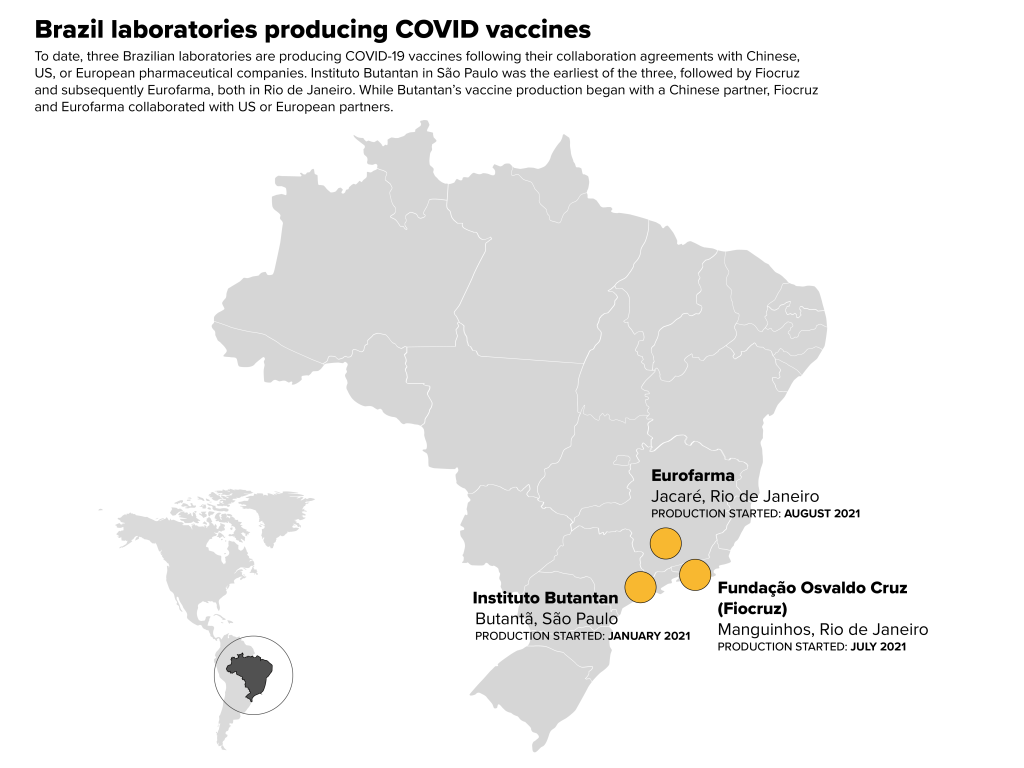
Furthermore, these laboratory-to-laboratory partnerships built technological and production capacity in Brazil, resulting in a level of COVID-19 vaccine self-sufficiency unseen in most LAC nations. It could enable Brazil to become a “launching pad” for vaccine exports and possibly donations. Sinovac and Butantan’s agreement is a prime example. The president of the Butantan Institute projects that most of the 100 million Sinovac-CoronaVac doses produced yearly will be exported to Latin America and Africa beginning in 2022. Not unlike the United States and China, Brazil’s ability to produce vaccines itself could eventually allow it to advance foreign policy objectives and build goodwill with other countries in need.
Brazil’s unique case illustrates three important points. First, limited US and Chinese vaccine donations yielded less traditional vaccine diplomacy competition. Second, laboratory agreements uncover a different type of vaccine diplomacy: one that occurs at the subnational level (CoronaVac’s initial use). Finally, vaccine dynamics in Brazil involved more international players than the United States and China, as the AstraZeneca agreement demonstrates.
Mexico
By Bosco Marti
US and Chinese engagement with Mexico has been visible before and throughout the pandemic, including memorable milestones such as the North American Leaders’ Summit. Early on, Mexico sought help from the United States – its most important and reliable ally – to buy needed PPE equipment and N-95 masks. US support did not immediately materialize due to both countries’ similar peaks in caseload. This created pockets of diplomatic opportunities for other countries including China. Since China had an earlier first wave of COVID-19 infections, it had “off-cycle” pandemic peaks that allowed it to provide vaccines and other supplies when Mexico needed them the most. A Mexico – China air bridge was established via Aeromexico to secure the needed PPE materials.28“Feature: Massive Air Bridge Unites China, Mexico in Battling COVID-19,” Xinhua News, last modified May 14, 2020, accessed November 7, 2021, http://www.xinhuanet.com/english/2020-05/14/c_139054655.htm. US support eventually came, as Mexico was the first Latin American country to benefit from vaccine donations.29Tamara Keith, “Biden Takes First Jab at Vaccine Diplomacy, Sharing Doses with Mexico, Canada,” National Public Radio, last modified March 19, 2021, accessed November 7, 2021, https://www.npr.org/2021/03/19/979279426/biden-takes-first-jab-at-vaccine-diplomacy-sharing-doses-with-mexico-canada. By September 2021, the United States had donated 10.9 million vaccine doses; in contrast, China sold vaccines via purchasing agreements.30“Mexico Leans on China After Biden Rules Out Vaccines Sharing in Short Term,” Reuters, last modified March 9, 2021, accessed November 7, 2021, https://www.reuters.com/article/us-health-coronavirus-mexico-vaccines/mexico-leans-on-china-after-biden-rules-out-vaccines-sharing-in-short-term-idUSKBN2B11OY. In total and to date, Mexico has received (donated and purchased) more than 250 million vaccine doses across all foreign sources.31“First Shipment of Moderna Vaccines Donated by the US Arrives,” Gobierno de México (Federal Government of Mexico’s website), accessed November 7, 2021, https://www.gob.mx/sre/prensa/first-shipment-of-moderna-vaccines-donated-by-the-us-arrives. See also Chase Harrison, Luisa Horwitz, and Carin Zissis, “Timeline: Tracking Latin America’s Road to Vaccination,” Americas Society/Council of the Americas, last modified November 1, 2021, accessed November 7, 2021, https://www.as-coa.org/articles/timeline-tracking-latin-americas-road-vaccination.
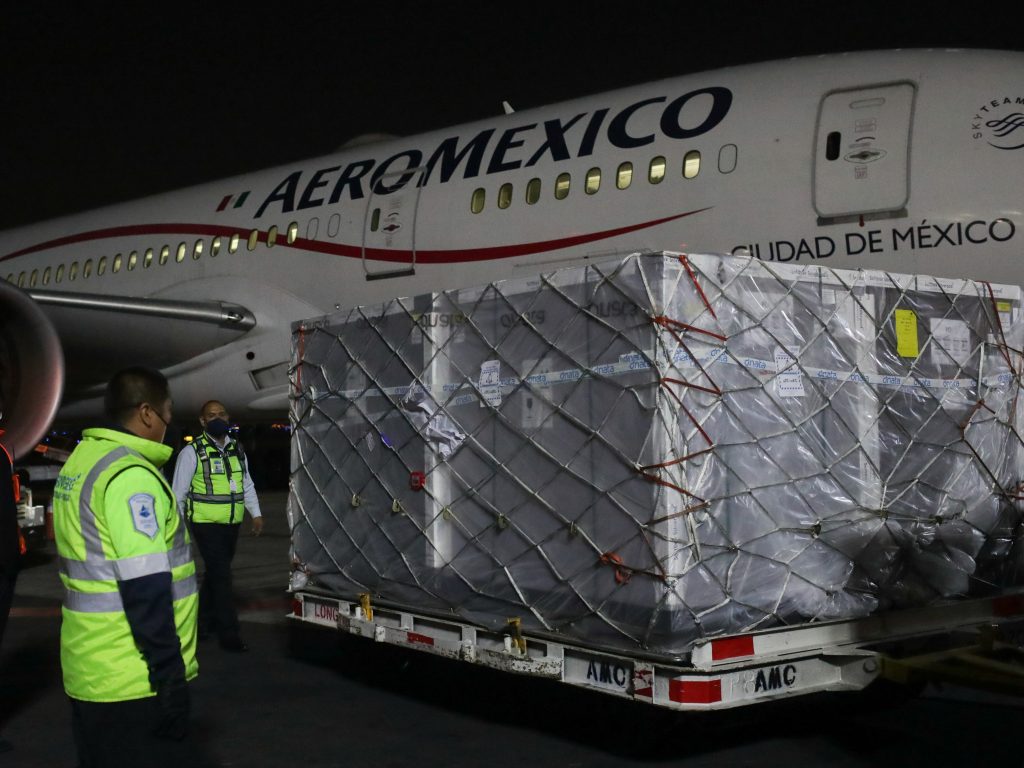
Accompanying those vaccine purchases were diplomatic exchanges and new agreements between Mexico and China. In April 2021, Chinese legislator Li Zhansu held talks on vaccines and other foreign policy issues with Oscar Eduardo Ramirez Aguilar, the speaker of Mexico’s Senate.32“China, Mexico Pledge Enhanced Cooperation to Promote Ties,” Xinhua News, last modified April 20, 2021, accessed November 7, 2021, http://www.xinhuanet.com/english/2021-04/20/c_139893420.htm. In September 2021, Mexican Foreign Secretary Marcelo Ebrard spoke with his counterpart in China, Foreign Minister Wang Yi, about vaccines and other foreign policy priorities.33“Wang Yi Speaks with Mexican Foreign Minister Marcelo Ebrard on the Phone,” Chinese Ministry of Foreign Affairs, last modified September 29, 2021, accessed November 7, 2021, https://www.fmprc.gov.cn/mfa_eng/zxxx_662805/t1911171.shtml. Such high-level executive and legislative exchanges reveal the depth of China-Mexico pandemic diplomacy, which has brought about new accords. For example, Mexico and China signed an important medical cooperation agreement in April 2021.34“Mexico and China Sign Regulatory Cooperation Agreement for Medical Supplies,” Gobierno de México, last modified April 21, 2021, accessed November 7, 2021, https://www.gob.mx/sre/prensa/mexico-and-china-sign-regulatory-cooperation-agreement-for-medical-supplies?idiom=en. The agreement is intended to expedite regulatory requirements for vaccines and medical devices shipped between the two countries.
For its part, the United States supported Mexico’s fight against the pandemic through vaccine donations and broader health collaboration. For instance, at the North American Leaders’ Summit (which also included Canada), a key deliverable was continued cooperation to increase vaccine donations throughout the hemisphere, strengthen medical supply chains, prepare for the next pandemic, promote equitable economic growth, and coordinate on migration issues. On one hand, the interconnectedness of US-Mexico health and prosperity represents a unique edge for the United States over China. On the other, Mexico-China relations arguably benefited from a more singular focus on vaccine arrivals and Mexican media coverage of it.35“¿Cuáles son las vacunas chinas contra el COVID-19 que usa México?,” El Universal, last modified March 24, 2021, accessed November 7, 2021, https://www.eluniversal.com.mx/ciencia-y-salud/cuales-son-las-vacunas-chinas-contra-el-covid-19-que-usa-mexico.
Overall, Mexico skillfully navigated US-China dynamics during the pandemic to its advantage. Before the March 2021 US vaccine donation, President Andrés Manuel López Obrador had asked the Biden administration for help but it was slow in coming (US vaccines came later that month).36“Mexico Leans,” Reuters. As he had with the PPE request, he turned to China to purchase a batch of twenty-two million doses. This was an important point in the triangular dynamics of relations among the United States, China, and Mexico—indicative of Mexico’s agency and ability to independently negotiate with other countries should it deem US responses insufficient to Mexican needs. Similar power dynamics were observed in 2017, when then-Mexican President Enrique Peña Nieto visited China amid faltering trade negotiations with Washington.
Looking ahead, vaccine and health collaboration will continue to provide China and the United States with additional pathways to engage LAC. However, unlike many LAC countries where China has made considerable commercial headway, Mexico is unique in the scale and scope of its economic relationship with United States—by far its largest trade and investment partner—as well as shared history, culture, and other interests.37“Mexico,” Office of the United States Trade Representative (website), accessed November 7, 2021, https://ustr.gov/countries-regions/americas/mexico. Thus, the US remains a reliable partner to Mexico despite the initial delayed start in vaccine provision, due to the depth and breadth of interlocking ties and both countries’ incentives in maintaining them. A pivotal element related to the dynamics among these three nations during and after the pandemic is a game of (distant) catch-up: will the United States be more successful in leveraging vaccine diplomacy to cement Mexico ties, or will China be more successful in using it to diversify and upgrade existing relations with Mexico?
Conclusion
The pandemic itself may be an anomaly, but US-Chinese-LAC dynamics during it are not a unique event. US and Chinese COVID-19 assistance and vaccine diplomacy are part of a broader trend in the triangular relationship. LAC proximity means that the United States will always have an interest in the health of the hemisphere. China’s growing global reach means that it will not ignore an entire region that holds considerable resources. Meanwhile, since LAC governments are disproportionately affected by global circumstances—such as climate change, economic swings, and the economic fallout from the pandemic, in particular—these leaders will always seek support from willing partners.
While the pandemic exemplifies the opportunities created by global trends for US and Chinese engagement in LAC and their different strategies, it also underscores the role of pragmatism (local needs and perceptions) in driving LAC policies and actions. At the early height of the pandemic, the quantity and timing of vaccine shipments and bilateral diplomatic engagements had two likely implications: helping to shape citizens’ perceptions of US and Chinese support;38Evan Cooper and Mathew Burrows, “Reality Check #6: The Consequences of an ‘America First’ Vaccine Policy,” Atlantic Council, May 12, 2021, accessed December 23, 2021, https://www.atlanticcouncil.org/content-series/reality-check/reality-check-6-the-consequences-of-an-america-first-vaccine-policy/. and potentially improving perceptions of US and Chinese support during future global events and disasters. Understanding these implications provides more tools to US and LAC policymakers as they aim to better serve the hemisphere’s needs.
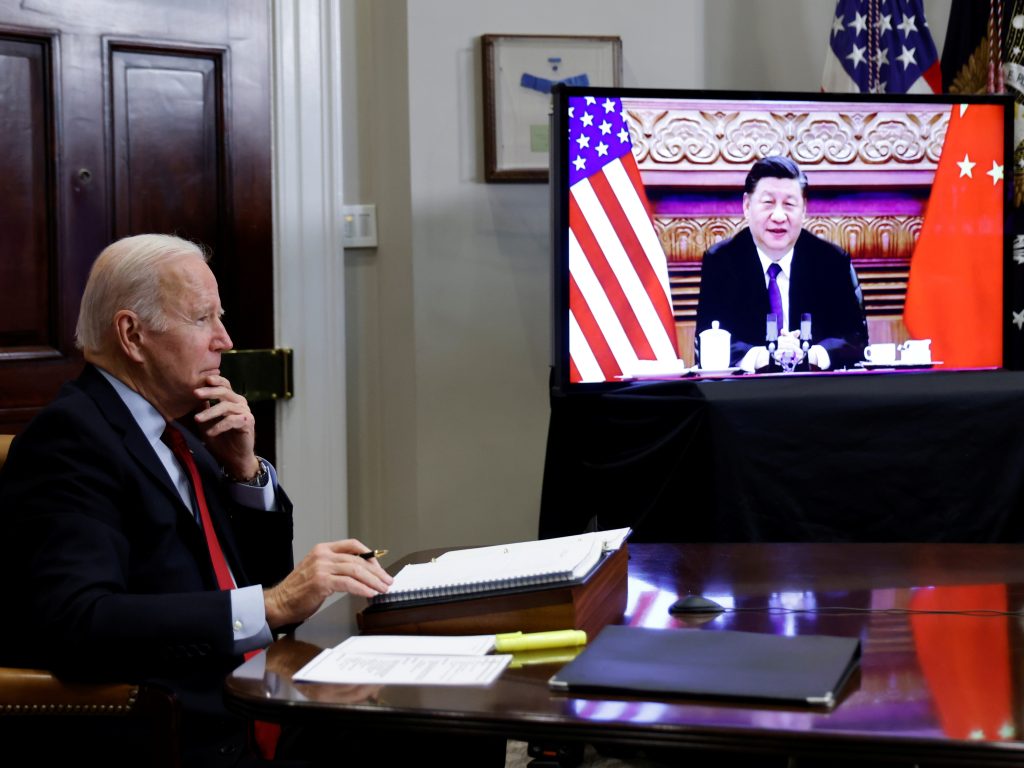
The case studies provide the following broader insights into these dynamics.
- LAC leaders court the United States and China: LAC governments are using US-Chinese dynamics to their advantage. The impact on the health of LAC citizens and on regional economies created an urgency among leaders to secure resources, vaccines, and assistance. LAC leaders initially sought aid from China and other allies because US vaccines had not arrived. Yet even when US vaccines arrived, LAC governments remained engaged with China. Although US material support was limited or slow in some cases, it eventually grew. The United States continued to engage the region by providing pandemic assistance and cooperation on other issues, such as migration, security, and climate change. Thus, the pandemic highlights an important trait in US-Chinese-LAC relations: regional governments do not view China as a replacement for the United States—or vice versa—but as an additional or alternative source of external support.
- The number of bilateral vaccine shipments (donations plus purchases) matter: The scale and number of Chinese vaccine shipments to LAC is an important point. The implications are twofold: bilateral vaccine shipments were greeted by regional media headlines and provided more opportunities for Chinese officials to meet with local leaders and government ministers; and the public places greater emphasis on being vaccinated rather than where the vaccine was developed (whether donated or purchased). Many US donations, including several supplied through and co-branded with the multilateral COVAX facility, did not generate similar impact in public perception. In addition, only ten LAC countries are qualified for the COVAX Advance Market Commitment (“AMC”) mechanism, designed to cover the purchase of vaccine doses by qualifying low-income countries. The remaining LAC countries signed self-financing agreements with COVAX. Those that did qualify for COVAX’s AMC mechanism received smaller and delayed quantities relative to larger, quicker Chinese shipments.
- Timing and consistency are key: While LAC benefited from assistance by both the United States and China early in the pandemic, Chinese vaccines arrived first. Delivering vaccines before the United States allowed China to build goodwill with regional leaders and caused LAC citizens to question the timing of US donations. Second, timely Chinese shipments highlighted sustained and consistent support to LAC—something the region routinely calls for from the United States. Whereas China’s COVID-19 PPE assistance was followed by vaccine shipments, US bilateral vaccine support came after a monthslong gap.
- Diplomacy is the perfect complement: Chinese assistance to LAC was usually accompanied with media headlines and coincided with high-level and subnational diplomacy. In El Salvador and T&T, for example, China used photos with national ministers and speeches at LAC airports during vaccine arrivals to bring national and international media attention to its actions. The United States used a similar model during its vaccine shipments, though in most cases with less fanfare. However, China also engaged more diligently and directly with LAC leaders. Xi called LAC leaders when they were infected with COVID-19 to promise vaccine donations, and to discuss other accompaniments including new loan agreements. Former President Trump rarely engaged with LAC during the pandemic, and Biden’s interactions were limited mostly to multilateral settings, whereas Xi’s interactions were bilateral.
Acknowledgments
We would like to thank the Atlantic Council for the opportunity to share regional perspectives and analyses on US and Chinese support during the COVID-19 pandemic. As regional governments look to the international community for support, we hope this report can shed a light on best practices and strategies to engage with LAC countries.
At the Atlantic Council, we would like to thank Jason Marczak and Pepe Zhang for their leadership and guidance; Susan Cavan and Beverly Larson for editorial assistance; and Donald Partyka and Nancy Messieh for design support, particularly in the infographic process. Finally, a special thank you to Isabel Bernhard whose editorial guidance, thought leadership, and valuable analysis underpinned many of the unique ideas in this report. Her contribution was critical to the report’s ideation, development, and completion.
About the authors
María Eugenia Brizuela de Ávila (“Mayu”) is a Non-resident Senior Fellow at the Adrienne Arsht Latin America Center, as well as a former and first female Minister of Foreign Affairs of El Salvador. She also possesses extensive experience in the private sector as a former president of an insurance company, a former president of a private bank, and an independent director on several bank boards in El Salvador and Honduras. Her expertise across diplomacy and development has been recognized by the Aspen Ministers Forum, Vital Voices, and the Adrienne Arsht Latin America Center. She holds a law degree from the Universidad Dr. Jose Matias Delgado in El Salvador and additional academic titles from the University of Cambridge, the Sorbonne, and INCAE.
Riyad Insanally is a Non-resident Senior Fellow at the Caribbean Initiative of the Adrienne Arsht Latin America Center. He was Guyana’s Ambassador to the United States and Permanent Representative to the Organization of American States from 2016 to 2021. Ambassador Insanally was a career diplomat for over 31 years and received Guyana’s third highest award, the Cacique’s Crown of Honour, in 2019 for his service to diplomacy and international relations. He studied Modern Languages and Latin American Studies and holds MA and MPhil degrees from the University of Cambridge and a PhD from Harvard University.
Claudia Trevisan is the executive director of the China-Brazil Business Council (CEBC). As a career journalist with over 30 years of experience, she has worked as a correspondent for leading Brazilian newspapers in the United States, China, and Argentina and authored two books on China. Claudia received her master’s degree from the School of Advanced International Studies/Johns Hopkins University in 2019, followed by one year as a non-resident fellow at SAIS’s Foreign Policy Institute.
Bosco Martí is a Non-resident Senior Fellow with the Atlantic Council’s Adrienne Arsht Latin America Center and is the global director of institutional affairs and communications for Aleatica, a multinational transportation infrastructure operator. Martí served for six years as executive director for Mexico and the Dominican Republic at the board of directors of the Inter-American Development Bank and the Inter-American Investment Corporation. He has also held senior positions in Mexico’s Ministry of Foreign Affairs and the Office of the President. Martí holds a BS in industrial engineering from Universidad Iberoamericana in Mexico City.
Wazim Mowla is the assistant director for the Caribbean Initiative at the Adrienne Arsht Latin America Center, where he works on the Caribbean and China portfolios. Mowla holds a bachelor’s degree in international relations and a master’s degree in history from Florida International University, where he is currently a nonresident scholar for the Jack D. Gordon Institute for Public Policy. Mowla provides frequent commentary for US and Caribbean media outlets.
Related content
Image: A load of Sinovac's coronavirus disease (COVID-19) vaccine is unloaded from a Brazilian Air Force airplane after the regulator Anvisa approved its emergency use, at Brasilia Air Base in Brasilia, Brazil, January 18, 2021. REUTERS/Adriano Machado
